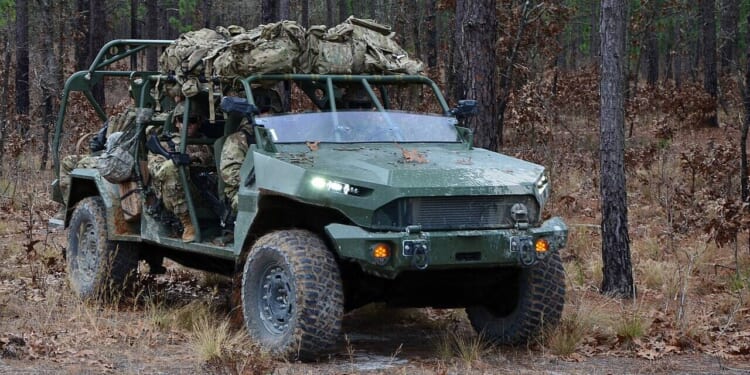The Pentagon is spending years and billions chasing the next generation of exquisite systems. Meanwhile, the Army has quietly shown up with something far more disruptive: a low-cost, off-the-shelf troop carrier that startups are now transforming into a laboratory for autonomy, sensors, and AI. The vehicle in question is called the Infantry Squad Vehicle (ISV), and it’s proving that America doesn’t need to wait for massive programs of record to innovate. The future of modernization may already be rolling across training ranges—and it is cheap, flexible, and soldier-tested.
What to Know About the US Army’s Infantry Squad Vehicle
Originally conceived as a lightweight, off-the-shelf way to move troops around the battlefield, the ISV was never meant to be revolutionary. Yet its simplicity and availability have made it an ideal platform for experimentation. Startups are now modifying ISVs with autonomous navigation kits, modular sensor payloads, hybrid-electric drives, and even AI-enabled mission systems.
Because the ISV is inexpensive and fielded in numbers, soldiers can test these emerging technologies in realistic conditions without risking multi-billion-dollar assets. The result is rapid iteration: new capabilities can be quickly bolted on, trialed in exercises, and refined through soldier feedback. If this pattern—non-stop innovation in warfare, almost in real time in response to battlefield conditions—sounds familiar, it is likely because it is exactly what is going on in the conflict in Ukraine today. Someone in the Army is paying attention to the paradigm shift, and Army leadership appears not only to fully support, but to be actively participating in ISVs development.
This bottom-up innovation model, pairing military needs with commercial ingenuity on an adaptable platform, should be the Pentagon’s blueprint for modernization. The ISV proves that the United States does not need to wait for massive programs of record to deliver finished products. Instead, it can evolve incrementally, in the field, at the speed of relevance.
What the Pentagon Can Learn from the ISV’s Development
The Army’s ISV approach offers lessons for the rest of the force. Consider the Air Force’s B-52 bomber, the Army’s Abrams tank, or the Navy’s Arleigh Burke destroyers. All were designed decades ago, yet they remain essential because they can absorb upgrades.
If these platforms were treated not just as operational workhorses but as innovation labs, they could host the same kind of rapid experimentation the Army is pursuing with the ISV. Imagine, for example, Abrams tanks running modular AI kits to test semi-autonomous maneuvers, or destroyers serving as motherships for unmanned drone swarms. Instead of waiting for perfect replacements, the Pentagon should use the platforms it has, or ones it can easily acquire, to field-test the capabilities of tomorrow.
This approach also helps solve one of DOD’s chronic political problems. Congress rarely allows the Pentagon to retire legacy systems before replacements are ready, as many fear capability gaps and industrial base disruptions following retirements. This often means that the Pentagon is stuck funding aging platforms, while newer and riskier programs languish.
Reframing these older systems as “innovation labs” changes the debate. Instead of endless fights over divestment, the Pentagon can request modest funds to upgrade legacy systems for experimentation. That keeps capability in the force, satisfies Congress, and produces the operational data needed to make smarter, faster decisions about the future force.
How Can the Department of Defense Embrace Innovation?
In an era of continuing resolutions and budget gridlock, leveraging existing platforms as labs is one of the few modernization strategies that is both politically feasible and fiscally pragmatic.
To succeed, however, the Pentagon must change its culture. Acquisition officials need to move from risk avoidance to managed experimentation. Warfighters must be empowered to provide feedback from real-world use, not just test ranges. As the Army looks to reorganize its acquisition workforce, it must do so in a manner that places these acquisition professionals at the same location as the warfighters, but also in support of them. The model that created these acquisition entities as separate standalone organizations should be abolished as they simply do not work as planned.
This would force the bureaucracy to adapt. Instead of locking innovation into decade-long cycles, program managers could insert capabilities incrementally, guided by operational lessons.
Critics worry that focusing on legacy experimentation could siphon attention from next-generation programs. But the ISV shows this is not an either-or proposition. Legacy platforms can accelerate the maturity of emerging technologies, ensuring that when new systems finally arrive, they are more capable and less risky.
Others raise concerns about deploying experimental technologies in combat. This is simply a wrong assessment of risk. The actual risk in warfighting is not deploying new technologies. The Pentagon’s greatest danger is paralysis: waiting years for pristine solutions, while competitors more rapidly iterate.
The Army’s ISV experiments offer a glimpse of a future where the Pentagon innovates faster, cheaper, and closer to the fight. They show that modernization is not always about buying new equipment. More often, it is about using what we already have in smarter, more flexible ways.
America’s existing legacy platforms—the B-52 Stratofortress bomber, the M1 Abrams tank, the Arleigh Burke-class destroyer, and other enduring platforms—should follow the ISV’s path. Their respective service branches must treat them not as relics or placeholders, but as living laboratories for the technologies that will define tomorrow’s wars.
If the Army can unlock remarkable innovation with a simple truck, why can’t the entire Pentagon do the same with billion-dollar platforms? The real question for Pentagon leadership is whether they have the will to follow the Army’s lead, or whether they will let America’s innovation gap continue to grow.
About the Author: John Ferrari
Maj. Gen. John G. Ferrari is a nonresident senior fellow at the American Enterprise Institute. Over his 32-year US Army career, Ferrari, who is now retired, served as the director of program analysis and evaluation, the commanding general of the White Sands Missile Range, and a deputy commander for programs at the NATO Training Mission in Afghanistan. He has an MBA in finance and strategic management from the Wharton School at the University of Pennsylvania, an MA in national resource strategy and policy from the Industrial College of the Armed Forces (now called the Eisenhower School for National Security and Resource Strategy), and a BS in computer science from the United States Military Academy at West Point.
Image: US Army.


















